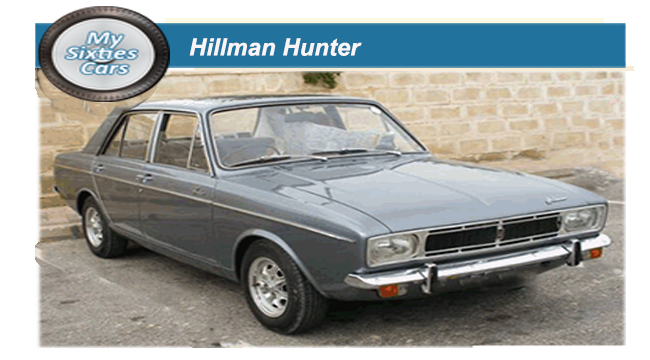 Inspired, some say, by the success of the original Ford Cortina, the Rootes Group Hillman Hunter should have been among the group’s best-selling models of the Sixties.
Inspired, some say, by the success of the original Ford Cortina, the Rootes Group Hillman Hunter should have been among the group’s best-selling models of the Sixties.
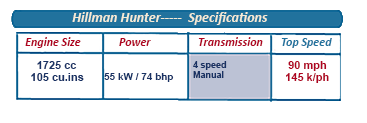 ULtimately the Hillman Hunter failed even to approach the tremendous commercial and critical success that the Ford and several other UK produced models enjoyed in the Sixties - even though the Hunter cost less to build than post of its rival’s in the mid-range family saloon sector.
ULtimately the Hillman Hunter failed even to approach the tremendous commercial and critical success that the Ford and several other UK produced models enjoyed in the Sixties - even though the Hunter cost less to build than post of its rival’s in the mid-range family saloon sector.
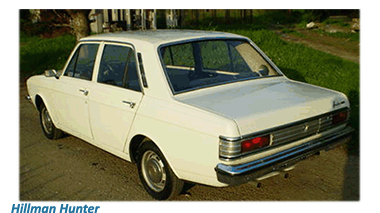 Following in the footsteps of the Minx family which had allowed Hillman to establish a double-edged reputation, for producing solidly built family cars that were comfortable but providing rather dull performance and only average economy.
Following in the footsteps of the Minx family which had allowed Hillman to establish a double-edged reputation, for producing solidly built family cars that were comfortable but providing rather dull performance and only average economy.
Despite that, the new Hunter was lighter, had more power, burned less fuel and yet was just as comfortable and reassuringly 'solid' as the earlier machines.
Taking another leaf out of Ford's book, the Hillman Hunter, first to be released as part of the Rootes Group "Arrow" project offered a variety of engines, bodies, and specifications to suit the pockets and tastes of a broad spectrum of potential buyers.
Powered by a 1725cc engine, teamed to a four-speed all-synchromesh gearbox, the Hunter also came with optional overdrive or Borg-Warner automatic transmission, hybrid-bevel rear axle and front disc/rear drum braking installation.
![]()
Fleet operators, a potential client to be reckoned with, became the driving forces behind Hillman's decision in 1967 to a 1496cc (91 cu in) engine as an option.
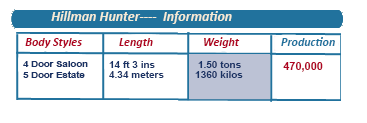 All of these options all slightly revised derivatives from those used on the Minx and Super Minx models, which were discontinued to be replaced by the Hunter.
All of these options all slightly revised derivatives from those used on the Minx and Super Minx models, which were discontinued to be replaced by the Hunter.
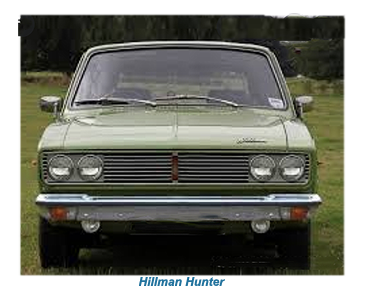 Available as either a four-door saloon/five-door estate car on a monocoque shell, the Hillman Hunter had a much sharper line than either of its predecessors.
Available as either a four-door saloon/five-door estate car on a monocoque shell, the Hillman Hunter had a much sharper line than either of its predecessors.
The Hunter’s s light weight made it much easier to handle than any other previous Hillman, with the notable exception of the Imp, also powered by an aluminium engine.
The Mk II of 1967 received a mild cosmetic makeover, while much-needed servo-assisted brakes became standard on the Hunter from 1968.
Maximum speed was a brisk 92 mph, and the 0-50 mph time was cut to 9.3 sec. Better still, fuel consumption was as good as 32 mpg overall.
![]()
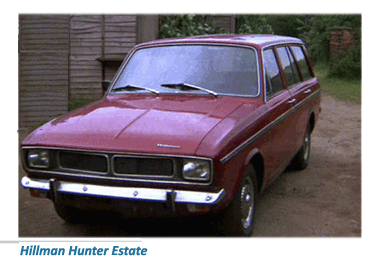 Internally, reclining front seats and a bench rear were deep and comfortable, while a very efficient fresh-air heating and ventilation system that included omnidirectional fascia vents. Opening quarter-lights were still retained, surprisingly, and contributed to rather high wind noise level at speed.
Internally, reclining front seats and a bench rear were deep and comfortable, while a very efficient fresh-air heating and ventilation system that included omnidirectional fascia vents. Opening quarter-lights were still retained, surprisingly, and contributed to rather high wind noise level at speed.
Despite being mostly inconspicuous and unexciting, the Hillman Hunter did remain in production till the late Seventies, selling steadily across the globe, with Rootes and Chrysler establishing production and assembly units in Australia and New Zealand and even Iran.
The Hunter proved to be a big hit in Teheran where its longevity and robustness was much appreciated, with a credible number still operating till today.






